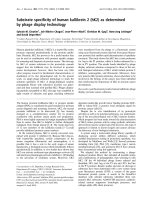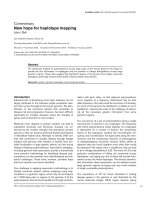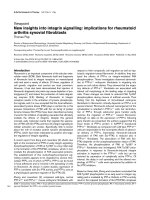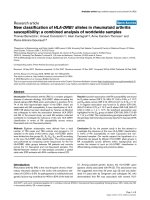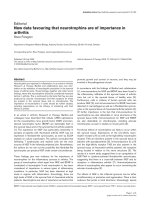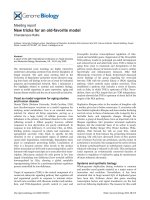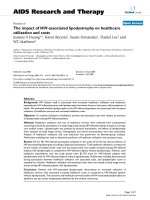Báo cáo y học: " New York City HIV superbug: fear or fear not?" pdf
Bạn đang xem bản rút gọn của tài liệu. Xem và tải ngay bản đầy đủ của tài liệu tại đây (194.31 KB, 3 trang )
BioMed Central
Page 1 of 3
(page number not for citation purposes)
Retrovirology
Open Access
Commentary
New York City HIV superbug: fear or fear not?
Stephen M Smith*
1,2
Address:
1
Section of Infectious Diseases, Department of Medicine, Saint Michael's Medical Center, New Jersey, USA and
2
Department of Preventive
Medicine and Community Health, The New Jersey Medical School, Newark New Jersey 07102, USA
Email: Stephen M Smith* -
* Corresponding author
Abstract
On February 11, 2005, the New York City Department of Health and Mental Hygiene announced
that a city resident had recently been infected with a multi-drug resistant form of HIV and rapidly
progressed to AIDS. The Health Commissioner, Thomas R. Frieden, called for increased vigilance
against this new strain. Is this situation an emerging crisis or simply an unusual case report of rapid
HIV progression?
On February 11, 2005, New York City (NYC) health offi-
cials announced the discovery of a "rare strain of multi-
drug resistant HIV that rapidly progresses to AIDS."
According to the NYC Department of Health and Mental
Hygiene, a man in his mid-40s was diagnosed with HIV
infection in December 2004. Shortly after his diagnosis,
testing, at the Aaron Diamond AIDS Research Center in
Manhattan, revealed that his virus was resistant to almost
all anti-HIV therapeutics. Further, despite being infected
for only 2–20 months, the man had developed AIDS.
NYC Health Commissioner Thomas R. Frieden, MD,
MPH, stated, "This case is a wake-up call. First, it's a wake-
up call to men who have sex with men, particularly those
who may use crystal methamphetamine now, we've
identified this strain of HIV that is difficult or impossible
to treat and which appears to progress rapidly to AIDS."
Dr. Frieden called on this community to help stop the
spread of this and other drug resistant strains of HIV. He
also called on NYC doctors and the public health system
to improve HIV prevention counseling, to perform HIV
drug resistance testing among treatment naïve, HIV
+
per-
sons, and to improve anti-HIV drug adherence.
At the 12
th
Conference on Retroviruses and Opportunistic
Infections (CROI) in Boston, Drs. David Ho and Martin
Markowitz of the Aaron Diamond AIDS Research Center
in Manhattan presented clinical and laboratory data
regarding the NYC resident[1]. He had tested negatively
for HIV-1 antibodies several times before and in May
2003. His total lymphocyte counts during these time
points were repeatedly normal. Investigators believe that
the NYC resident may have been infected in October
2004, when he, while on crystal methamphetamine,
engaged in unprotected, receptive and insertive anal sex
with multiple partners. In early November 2004, the NYC
resident developed a febrile illness, and then in December
2004, he tested positive for antibodies against HIV. His
personal physician, concerned over the possibility of
recent acute HIV-1 infection, referred the NYC resident to
Dr. Martin Markowitz. At the time of diagnosis, his CD4
+
T-cell count was 80 cells/mm
3
and it has since fallen to
less than 50. The NYC resident meets one criterion for the
diagnosis of AIDS; his CD4
+
T-cell count is less than 200
cells/mm
3
. His viral load has varied from ~100 K to 650
K/ml. The NYC resident's virus was tested and found to be
resistant to all but two anti-HIV drugs, efavirenz (Sustiva
®
)
and enfuvirtide (Fuzeon
®
; T20). This high degree of drug
Published: 02 March 2005
Retrovirology 2005, 2:14 doi:10.1186/1742-4690-2-14
Received: 28 February 2005
Accepted: 02 March 2005
This article is available from: />© 2005 Smith; licensee BioMed Central Ltd.
This is an Open Access article distributed under the terms of the Creative Commons Attribution License ( />),
which permits unrestricted use, distribution, and reproduction in any medium, provided the original work is properly cited.
Retrovirology 2005, 2:14 />Page 2 of 3
(page number not for citation purposes)
resistance existed before the NYC resident was treated
with any anti-HIV compound.
Is this case a harbinger of a new epidemic with this super-
bug or is it just an isolated, forme fruste of HIV infection?
No one knows the answer to this question yet, but we do
have plenty of data to suggest that the latter is the case. In
people naïve to drug therapy, bone fide antiviral resist-
ance is uncommon. A recent USA based study of treat-
ment-naïve patients found that the prevalence of
mutations associated with drug resistance was 8.8%[2].
This means 8.8% of the subjects' viruses tested positive by
genotyping for 1 or more mutations associated with drug
resistance. Having a single mutation associated with
resistance does not necessarily make a virus drug resistant.
For many drugs, HIV must contain several mutations to
become resistant. This fact is true for most protease inhib-
itors (PIs) and for several nucleoside analogue reverse
transcriptase inhibitors (NRTIs). Therefore, the overall
level of drug resistance is well less than 8.8% reported in
this study. Indeed, in this study, no significant resistance
to protease inhibitors was seen. A similar study found the
overall prevalence of drug resistance mutations was 8.3%,
as also determined by genotyping[3]. However, when
viruses containing these mutations were analyzed by phe-
notyping, only 39% demonstrated decreased reduced
drug susceptibility. In other words, less than 3.5% of all
isolates had phenotypic resistance.
A commonly held view on why the level of drug resistance
is low is that most mutations associated with drug resist-
ance, also decrease viral fitness. Except the K103N reverse
transcriptase mutation, which confers resistance to the
three approved non-nucleoside inhibitors (NNRTIs),
other mutations, associated with high level drug resist-
ance, are thought to significantly decrease viral fitness.
Theoretically, in the absence of drug pressure in a newly
infected individual, wild-type virus is either selected for
during transmission or the transmitted, resistant virus
mutates back towards the fitter wild type. The current
observation is that the vast majority of viruses in treat-
ment-naïve patients are sensitive to almost all drugs.
In addition to CD4, the virus, isolated from the NYC resi-
dent, uses CXCR4 or CCR5 to enter cells[1]. Such viruses,
termed dual-tropic, are rarely seen in newly infected indi-
viduals. Typically, an R5 virus, which utilize CCR5, is the
transmitted type. After years of infection, in approxi-
mately 50% of individuals, the viruses' tropism changes
from CCR5 to CXCR4[4]. This phenotypic change is asso-
ciated with an accelerated disease course. People, who are
homozygous for the CCR5, 32-bp deletion, do not express
functional CCR5 and have a high relative resistance to
infection with HIV. In those ∆32 homozygotes, who have
become infected with HIV (8 individuals reported), the
disease course appears to be more rapid[5]. Most of these
individuals had CD4
+
T-cell counts less than 300 cells/
mm
3
at the time of diagnosis. It is unclear why these indi-
viduals became infected, while the vast majority of ∆32
homozygotes remain uninfected. Possibly, these 8 indi-
viduals have some other aberration, which allows them to
become infected with an X4 virus and, in turn, leads to an
accelerated disease course. Perhaps, the NYC resident has
a similar abnormality, which has lead to an increased rate
of CD4
+
T-cell depletion.
Also at CROI this year, Drs. Stephen Gange and Alvarez
Muňoz from Johns Hopkins University Bloomberg
School of Public Health presented models of rapid HIV
progression probability, based on two, large prospective
cohorts[6]. These studies, the MACS and theWIHS, have
been on-going for the past 21 and 11 years respectively
and have collected longitudinal data on 391 seroconvert-
ers. In the pre-HAART era, the median time to AIDS was
8.3 years. Using the cohorts' data, Drs. Gange and Muňoz
estimated the probability of clinical AIDS developing
within 6–24 months or a low CD4
+
T-cell count existing at
the first visit after diagnosis (within the first 9 months of
infection). Their model predicts that 7 in 10,000 patients
develop clinical AIDS within 6 months of infection. This
number increases to 45 in 10,000 after 12 months. Simi-
larly, 10 in 10,000 HIV infected individuals have a CD4
+
T-cell count less than 200 cells/mm
3
after 4.5–9 months
of infection.
Several reports of rapidly progressing HIV infection have
been published. The rapid disease course of the NYC resi-
dent is rare, but hardly unique. To date, no cluster of rapid
progressors has been described. All rapid progressors have
been unrelated, either genetically or virologically. While
multi-drug resistant (MDR) viruses may be overall less fit
compared with wild-type, drug sensitive strains, MDR HIV
still causes steady CD4
+
T-cell depletion. Therefore, it is
highly probable that the NYC resident has a genetic pre-
disposition, which led to rapid progression, rather than a
new strain of HIV-1, which is simultaneously super-
aggressive and multi-drug resistant.
Our experience at a large, inner city HIV clinic is in agree-
ment with the above data. We do not see rapidly progress-
ing, newly diagnosed individuals. We also do not see
MDR HIV in our treatment-naïve patients. Review of our
data does not reveal any evidence of MDR virus in per-
sons, who have never been on therapy.
To determine whether this "superbug" has spread to oth-
ers, the NYC Department of Health is appropriately and
aggressively investigating the sexual contacts of the NYC
resident. The reason for the NYC Department of Health
press release at this early point in the investigation is
Publish with BioMed Central and every
scientist can read your work free of charge
"BioMed Central will be the most significant development for
disseminating the results of biomedical research in our lifetime."
Sir Paul Nurse, Cancer Research UK
Your research papers will be:
available free of charge to the entire biomedical community
peer reviewed and published immediately upon acceptance
cited in PubMed and archived on PubMed Central
yours — you keep the copyright
Submit your manuscript here:
/>BioMedcentral
Retrovirology 2005, 2:14 />Page 3 of 3
(page number not for citation purposes)
unclear. In the absence of a documented cluster of
patients, should the entire health system react? No, we
should wait for more information. I do agree that geno-
typic resistance testing for treatment-naïve HIV
+
patients is
prudent, especially when the person is thought to have
been infected within the past year. Of course, most
patients do not know when they were infected, so we are
testing each new patient.
Given the availability of free, rapid testing for HIV in New
Jersey, we are strongly encouraging any one with current
or previous high-risk behavior to get tested and determine
his/her HIV status. The best way to fight this disease is
with knowledge: knowledge on one's infection status,
knowledge on how to avoid becoming infected, and
knowledge on how not to infect some one else. HIV is not
the common cold. It is transmitted through well-
described behaviors, predominantly sex, especially recep-
tive anal intercourse, and intravenous drug use with
shared needles. These behaviors can be modified to
reduce or eliminate the risk of contracting HIV. Two recent
studies conclude that universal testing for HIV is a cost
effective way to combat this infection in the USA [7-9].
Outreach prevention education and widespread testing
are probably more effective public health strategies than
sensational press releases. Dr. Frieden's call for increased
vigilance against drug resistant HIV implies that regular,
old-fashioned HIV infection is not horrific enough. Any
one who has seen this disease up close knows that is not
the case. While we have partially effective therapies and
we better understand its pathogenesis, HIV infection in
this country, not as life threatening as it once was, remains
quite life altering.
References
1. Markowitz M, Mohri H, Mehandru S, Shet A, Berry L, Kalyanaraman
R, Kim A, Chung C, Jean-Pierre P, Horowitz A, La Mar M, Wrin T,
Parkin N, Poles M, Petropoulos C, Mullen M, Boden D, Ho DD: A
Case of Apparent Recent Infection with a Multi-Drug-Resist-
ant and Dual-Tropic HIV-1 in Association with Rapid Pro-
gression to AIDS: February 24; Boston. ; 2005.
2. Novak RM, Chen L, MacArthur RD, Baxter JD, Huppler Hullsiek K,
Peng G, Xiang Y, Henely C, Schmetter B, Uy J, van den Berg-Wolf M,
Kozal M: Prevalence of antiretroviral drug resistance muta-
tions in chronically HIV-infected, treatment-naive patients:
implications for routine resistance screening before initia-
tion of antiretroviral therapy. Clin Infect Dis 2005, 40:468-474.
3. Weinstock HS, Zaidi I, Heneine W, Bennett D, Garcia-Lerma JG,
Douglas JMJ, LaLota M, Dickinson G, Schwarcz S, Torian L, Wendell
D, Paul S, Goza GA, Ruiz J, Boyett B, Kaplan JE: The epidemiology
of antiretroviral drug resistance among drug-naive HIV-1-
infected persons in 10 US cities. J Infect Dis 2004, 189:2174-2180.
4. Philpott SM: HIV-1 coreceptor usage, transmission, and dis-
ease progression. Curr HIV Res 2003, 1:217-227.
5. Sheppard HW, Celum C, Michael NL, O'Brien S, Dean M, Carrington
M, Dondero D, Buchbinder SP: HIV-1 infection in individuals
with the CCR5-Delta32/Delta32 genotype: acquisition of
syncytium-inducing virus at seroconversion. J Acquir Immune
Defic Syndr 2002, 29:307-313.
6. Gange S, Munoz A: Variations in the Natural History of HIV
Seroconverters in US Military Cohorts: February 24; Boston.
; 2005.
7. Bozzette SA: Routine screening for HIV infection timely and
cost-effective. N Engl J Med 2005, 352:620-621.
8. Paltiel AD, Weinstein MC, Kimmel AD, Seage GR, Losina E, Zhang H,
Freedberg KA, Walensky RP: Expanded screening for HIV in the
United States an analysis of cost-effectiveness. N Engl J Med
2005, 352:586-595.
9. Sanders GD, Bayoumi AM, Sundaram V, Bilir SP, Neukermans CP,
Rydzak CE, Douglass LR, Lazzeroni LC, Holodniy M, Owens DK:
Cost-effectiveness of screening for HIV in the era of highly
active antiretroviral therapy. N Engl J Med 2005, 352:570-585.
